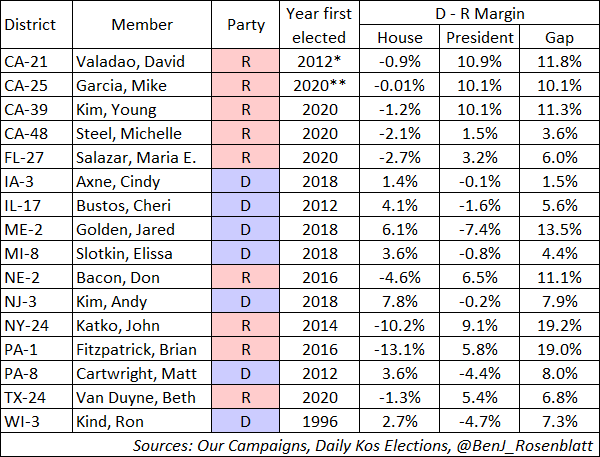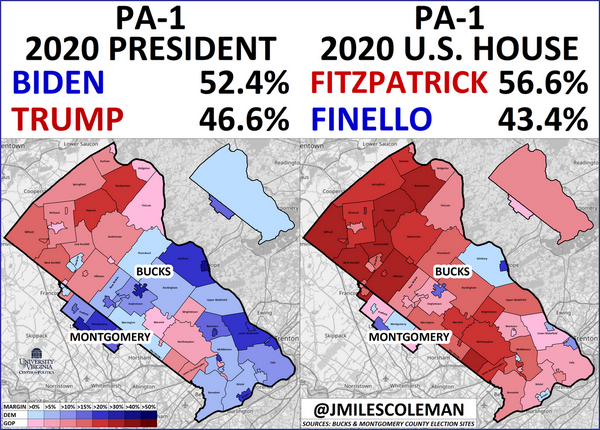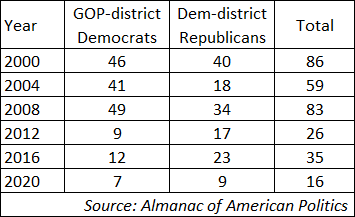KEY POINTS FROM THIS ARTICLE
— 16 members of the House hold districts that voted for the other party’s presidential nominee in 2020.
— Many Biden-district Republicans are from racially diverse areas, and they often came out on the winning end of rematches.
— Democrats held several Trump seats in both blue collar and suburban areas.
— Overall, the trend of ticket-splitting is on the decline — just a decade ago, it was common to see dozens of crossover districts.
Dwindling — but decisive — crossover districts
In a year where a historic presidential race dominated headlines, one of the biggest surprises of the 2020 election cycle was the House. Democrats, who controlled the chamber, were widely expected to gain seats. Instead, Speaker Nancy Pelosi (D, CA-12) lost several members of her caucus and came perilously close to losing her majority altogether.
Across the board, Republicans ran better than expected in key districts, even flipping some that now-President Biden carried. By the same token, Democrats owe their narrow majority to a handful of members who held on in seats that Donald Trump carried. So these “crossover districts” — seats that voted for one party’s presidential nominee but elected a House member of the other party — played a key role in determining the majority.
Though the official presidential breakdowns for some states are still being crunched, it appears that, all told, the 2020 election featured 16 crossover districts, listed in Table 1.
Table 1: Crossover districts in 2020

In some ways, Table 1’s roster speaks to how House Republicans overperformed expectations. Six of the nine Republican members who sit in Biden districts were not in office at the beginning of 2020. By contrast, the seven Trump-district Democrats all had at least one full term under their belts — or in the cases of Reps. Cheri Bustos (D, IL-17), Matt Cartwright (D, PA-8), and Ron Kind (D, WI-3), are veteran members of the caucus. On average, the Republicans ran further ahead of Trump in their districts (11.0%) than the Democrats did in theirs over Biden (6.9%).
Several Republicans won rematches
Geographically, California stands out on Table 1, as it has four districts that voted for Biden but sent Republicans to Congress. This quartet has certainly exhibited some electoral whiplash over the past several cycles: They were all in Republican hands prior to the 2018 midterms, flipped blue that year, but reverted back to the GOP. Last April, the Crystal Ball looked at how Democrats were probably overexposed in the Golden State after the anti-Trump 2018 cycle — they secured a 46-7 advantage in the state’s 53-member delegation, which was cut to a still-lofty 42-11 in 2020.
After the midterms, Washington Post opinion writer Henry Olsen noted that, for House Republicans who had just lost power, studying 2018’s gubernatorial results may offer a path back to the majority. Specifically, Democrats flipped several House districts that voted simultaneously for Republican gubernatorial candidates that year. In California, both CA-39 and CA-48, which include parts of the historically GOP but racially diverse Orange County, fell into that category — they both voted against now-Gov. Gavin Newsom (D-CA). In the former, now-Rep. Young Kim (R, CA-39) ran more than 20 percentage points ahead of Trump in many precincts, while now-Rep. Michelle Steel (R, CA-48) also overperformed him slightly but consistently throughout her district. Kim won a rematch against then-Rep. Gil Cisneros, while Steel defeated then-Rep. Harley Rouda. Rouda, a Democrat who seems intent on running again, is a strong candidate in his own right, but his clear 7% margin of victory in 2018 may have been inflated by his controversial opponent that year.
Going farther north in California, Republicans had other bright spots in the state. In May 2020, Republican Mike Garcia won a special election to replace former Democratic Rep. Katie Hill in CA-25, a district that sits atop the Los Angeles metro area. Garcia, a Hispanic Republican with a background as a Navy pilot, seemed like an ideal fit for an area which is home to several defense facilities. Garcia beat former state Rep. Christy Smith by a surprisingly strong 55%-45% in May and held on by just 333 votes in the November rematch, even as Biden carried the district by just over 10%.
The final Biden-district Republican in California is Rep. David Valadao (R, CA-21), who reclaimed a heavily Hispanic seat in the state’s Central Valley. Valadao first won his district in 2012, then held it until being upset by Democratic businessman T.J. Cox in 2018. Once in office, Cox struggled to make a positive impression on voters, as his image was weighed down by multiple ethics complaints. In a rematch where the challenger seemed more like an incumbent, Valadao reversed 2018’s result. CA-21 is a notoriously low-turnout area — in recent cycles, it’s typically cast the fewest raw votes of any California district — which can make for some electoral volatility, though this dynamic may have benefitted Valadao, as he was more of a local household name.
Florida and Texas have one first-term Biden-district Republican apiece. In the Miami area, Rep. Ileana Ros-Lehtinen (R, FL-27), the first Latina ever elected to Congress and a beloved figure in south Florida, retired in 2018, after nearly 30 years in office. In a district that Hillary Clinton won 58%-38% two years earlier, former Health and Human Services Secretary Donna Shalala (D, FL-27) won the seat by a seemingly underwhelming 52%-46% against journalist Maria Elvira Salazar. Despite the presidential topline, the area has a large Cuban-American population — a bloc that retains Republican proclivities down the ballot. While Trump made especially large inroads with Cubans in 2020, he improved throughout the entire area. Biden narrowly carried FL-27 but Shalala proved to be a weak candidate — as the area’s representative, she wasn’t even fluent in Spanish. In what’s becoming a common thread with Biden-district Republicans, Salazar won in a rematch.
Rep. Beth Van Duyne (R, TX-24) was the only non-incumbent Republican to hold an open seat that Biden carried. TX-24, which straddles Dallas and Fort Worth, was the sole Trump-to-Biden district in the state. Van Duyne’s win fit into a larger picture of Democratic down-ballot underperformance in Texas — though they eyed control of the state House, Democrats gained almost no ground in the legislature.
In Omaha, the Crystal Ball touched on Rep. Don Bacon’s (R, NE-2) overperformance shortly after the November election. Essentially, like Garcia, he seemed to fit his district especially well — and he also won in what was a rematch. In a race where Democrats had trouble uniting, Bacon snagged some visible cross-party endorsements.
In 2018, the blue wave crashed so hard in the House that only three Republicans remained in districts that Hillary Clinton carried. Rep. Will Hurd (R, TX-23) retired in 2020 — and his district, with its contrarian tendencies, flipped to Trump — but Reps. John Katko (R, NY-24) and Brian Fitzpatrick (R, PA-1) are still in office. Katko represents an Upstate New York seat centered on Syracuse and ran 19.2% ahead of his presidential nominee — the greatest gap of any member on Table 1. Fitzpatrick, who comes from a political family and frames himself as a pragmatist, has a district anchored in the swingy Bucks County, northeast of Philadelphia. He ran a similar 19% ahead of Trump (Map 1).
Map 1: PA-1 in 2020

Democrats retain working class areas, and some suburbs
Pennsylvania was the only state to have members from opposite parties on Table 1. Aside from Fitzpatrick, Rep. Matt Cartwright (D, PA-8) was reelected. With a political base in Scranton, he represents President Biden’s native district and won by 4%. Though he ran 8% better than Biden, Cartwright’s low single-digit margin seemed a bit underwhelming — several weeks before the election, the Democratic Congressional Campaign Committee pulled ads from his district, which seemed to signal their confidence in his race. Still, northeastern Pennsylvania skews whiter, is home to relatively few college graduates, and has been described to us by a state source as a “…genuinely populist” area. In other words, the Trumpian demographics of the area mean that even popular Democrats, such as Gov. Tom Wolf, have lost ground there recently.
Democrats retained three other districts that could be characterized as demographically similar to PA-8. Rep. Cheri Bustos (D, IL-17) chaired the DCCC for the 2020 cycle — on paper, her profile as a heartland Democrat from a Trump district made her an ideal member to recruit and train candidates, but she faced criticism throughout her tenure. Instead of adding to their majority, House Democrats ultimately lost about a dozen seats with Bustos at the helm, and she herself only pulled out a narrow 52%-48% win at home (she cleared 60% in her previous two races). In fact, Bustos did better as a challenger, when she originally won in 2012, than as a seasoned incumbent in 2020. To be fair, some of that was probably due to western Illinois’ overall reddening.
In an adjacent district to the north, Rep. Ron Kind (D, WI-3) is the longest-serving member on Table 1 but had the closest result of his career. It was surprising that Trump carried Kind’s western Wisconsin seat in 2016, but WI-3 got slightly redder last year. Republicans invested in this race but their candidate, retired Navy SEAL Derrick Van Orden, faced some bizarre headlines during the final stretch of the campaign. Kind ran ahead of Biden throughout the district, but there was still a lot more red than usual on his map (Map 2).
Map 2: WI-3 in 2020

The last predominantly working-class district that Democrats held was in northern Maine. First-term Rep. Jared Golden (D, ME-2) was reelected while his district gave Trump its electoral vote. A Marine Corps veteran who tried to cut out an independent profile during his term, Golden originally won in 2018 because of the state’s then-novel ranked-choice voting system. Golden appeared to be in a much stronger position for his second time around: he routinely led by double-digits in polls, and by the end of the cycle, it seemed the district had fallen off the board. He won by 6%, but there was some impressive ticket-splitting throughout his geographically vast district. Trump carried the city of Caribou, Sen. Susan Collins’ (R-ME) hometown, by 14% — down the ballot, they gave their GOP senator 71% but supported Golden 52%-48%.
The final three Trump-district Democrats are all second-term members in seats that are, to some degree or another, suburban. House Democrats hold 10 of New Jersey’s dozen House seats, but their only Trump-seat member is Rep. Andy Kim (D, NJ-3). Kim’s district is an odd combination of Burlington County, a blue county in the Philadelphia media market, and Ocean County, which is GOP turf that sits on the Atlantic coast. This tug-of-war led to a presidential result that was about tied. Kim was a strong fundraiser and ran against an opponent who faced carpetbagging accusations — Republican David Richter was originally running in the adjacent NJ-2, but was muscled out of the primary after then-Democratic Rep. Jeff Van Drew (R, NJ-2) changed parties.
In Michigan, Rep. Elissa Slotkin (D, MI-8) ran as a “Midwestern Democrat” and urged other members of her party to run active campaigns, despite then-candidate Biden’s rosy poll numbers. Slotkin holds a seat that runs from the state capital, Lansing, to the Detroit exurbs. Towards the end of the campaign, she scored a viral debate exchange where she shut down her opponent, Paul Junge, on healthcare.
Rep. Cindy Axne (D, IA-3) was the sole Trump-district Democrat to face, and prevail in, a rematch from 2018. Her district is nestled in Iowa’s southwestern corner and is the most urban of the state’s four districts — nearly 70% of its votes come from Des Moines’ Polk County and the neighboring Dallas County, the fastest-growing county in the state. Biden lost all of Iowa’s districts, but he came the closest in IA-3, coming within 600 votes of Trump there. While Axne matched the margin Biden got between the Polk and Dallas pair, she won by running more than five percentage points better than him throughout the rest of the district.
House races are moving closer to presidential outcomes
While the districts covered in this article represent a diverse cross-section of the House, after previous presidential elections, we’d have much larger samples to be sorting through. Indeed, over the last decade, House results have become increasingly correlated with presidential races. Since the 2000 election, the number of crossover districts has dwindled from 86 to 16 (Table 2).
Table 2: Number of crossover districts in presidential elections since 2000

In the first decade of the century, the number of crossover districts didn’t even seem dependent on the presidential environment. In 2000, with an infamously close presidential election, 86 districts had split outcomes, which was on par with the 83 from 2008, a Democratic wave year. During that span, the number of Democrats in Republican-won seats stayed about constant, in the 40s. Many of these districts were in the South and stayed blue because of their ancestral loyalties, popular incumbents, or both. In 2010, Democrats lost many of those seats in an anti-Obama midterm. Since then, Republicans have won more crossover districts in presidential election years.
Perhaps we’ll see more crossover districts in 2024 — especially if it’s an open-seat race, like 2016. But for now, to the disappointment of political junkies who love to study mixed results, the trend suggests more straight-ticket voting.
